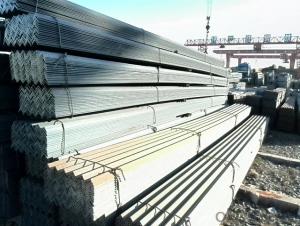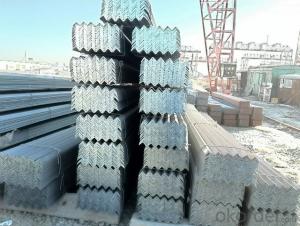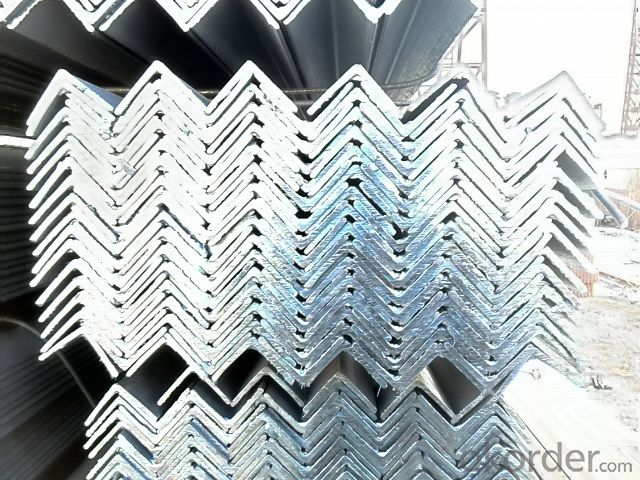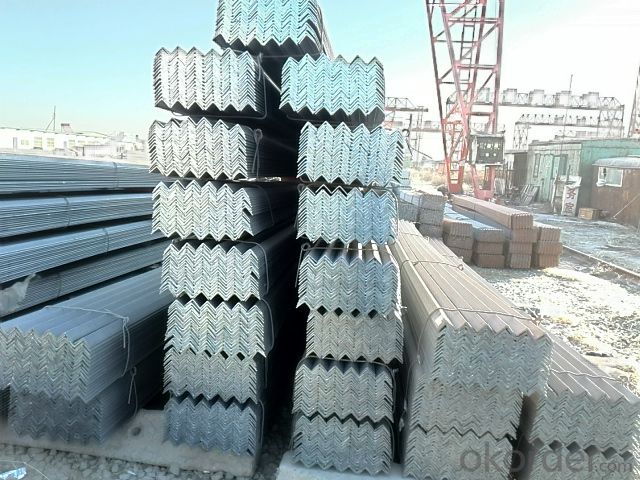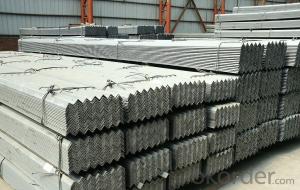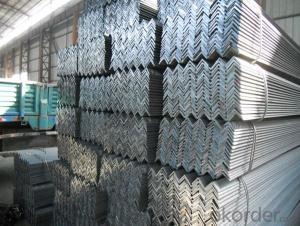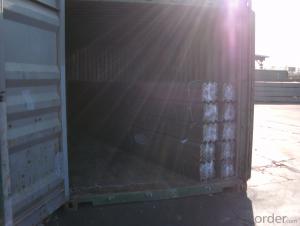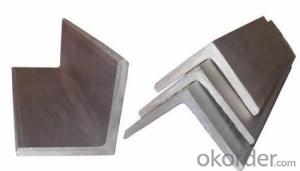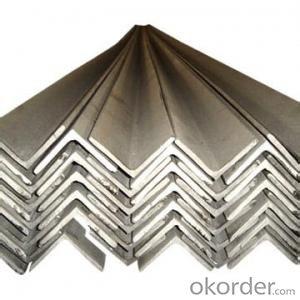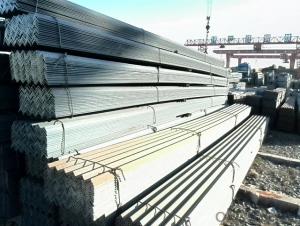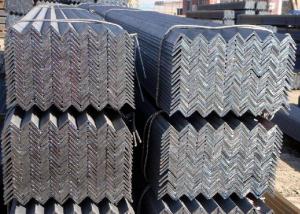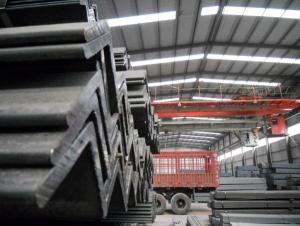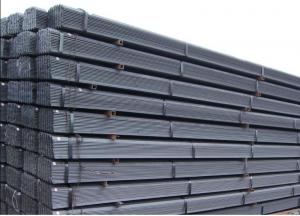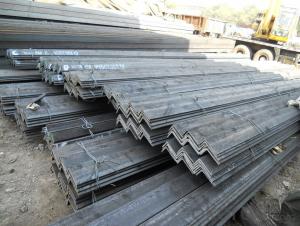Hot Rolled Steel Angle Bars in Grade Q235
- Loading Port:
- Tianjin
- Payment Terms:
- TT OR LC
- Min Order Qty:
- 25 m.t
- Supply Capability:
- 10000 m.t/month
OKorder Service Pledge
OKorder Financial Service
You Might Also Like
Specification
Okorder.com is a professional materials & equipment supplier & manufacturer, offers integrated one-stop services including real-time quoting and online cargo tracking. We are funded by CNBM Group, a Fortune 500 enterprise and the largest materials & equipment firm in China.
Product Applications:
According to the needs of different structures, Angle can compose to different force support component, and also can be the connections between components. It is widely used in various building structures and engineering structures such as roof beams, bridges, transmission towers, hoisting machinery and transport machinery, ships, industrial furnaces, reaction tower, container frame and warehouse etc.
Product Advantages:
OKorder's Steel Angles are durable, strong, and resist corrosion.
Main Product Features:
· Premium quality
· Prompt delivery & seaworthy packing (30-45 days after receiving deposit)
· Corrosion resistance
· Can be recycled and reused
· Mill test certification
· Professional Service
· Competitive pricing
Product Specifications:
1. Invoicing on theoretical weight or actual weight as customer request
2. Length: 6m, 9m, 12m as following table
3. Sizes

Sizes: 25mm-250mm | ||
a*t | ||
25*2.5-4.0 | 70*6.0-9.0 | 130*9.0-15 |
30*2.5-6.6 | 75*6.0-9.0 | 140*10-14 |
36*3.0-5.0 | 80*5.0-10 | 150*10-20 |
38*2.3-6.0 | 90*7.0-10 | 160*10-16 |
40*3.0-5.0 | 100*6.0-12 | 175*12-15 |
45*4.0-6.0 | 110*8.0-10 | 180*12-18 |
50*4.0-6.0 | 120*6.0-15 | 200*14-25 |
60*4.0-8.0 | 125*8.0-14 | 250*25 |
4.Material details:
Alloy No | Grade | Element (%) | |||||
C | Mn | S | P | Si | |||
|
|
|
|
|
|
| |
Q235 | B | 0.12—0.20 | 0.3—0.7 | ≤0.045 | ≤0.045 | ≤0.3 | |
|
|
|
|
|
|
| |
Alloy No | Grade | Yielding strength point( Mpa) | |||||
Thickness (mm) | |||||||
≤16 | >16--40 | >40--60 | >60--100 | ||||
≥ | |||||||
|
|
|
|
|
| ||
Q235 | B | 235 | 225 | 215 | 205 | ||
Alloy No | Grade | Tensile strength (Mpa) | Elongation after fracture (%) | ||||
Thickness (mm) | |||||||
| ≤16 | >16--40 | >40--60 | >60--100 | |||
≥ | |||||||
|
|
|
|
|
|
| |
Q235 | B | 375--500 | 26 | 25 | 24 | 23 | |
FAQ:
Q1.What's your payment terms ?
A1:1)100% irrevocable L/C at sight.
2)30% T/T prepaid and the balance against the copy of B/L.
3)30% T/T prepaid and the balance against L/C
4)100% irrevocable L/C at 90/120/180 sight.
Q2: The products are invoicing on theoretical weight or on actual weight?
A2: We can do it in both manners, it’s according to buyer's requirement.
Q3: Can fit in the containers of 20fts for 6M long ?
A3: Yes, we can put them into the containers in the form sideling, in this way we can save the buyer much ocean freight.
Images:
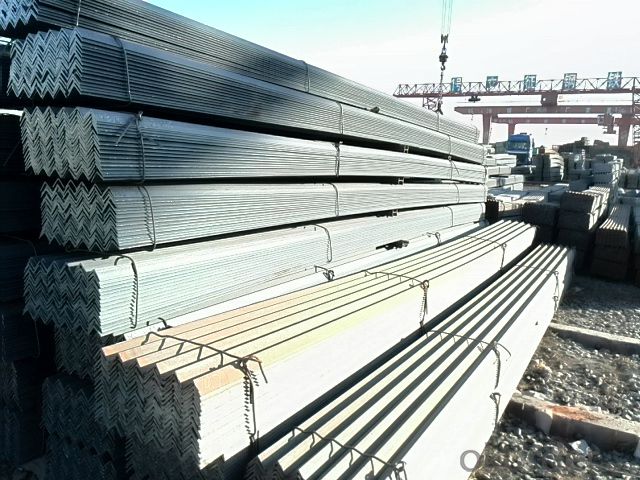
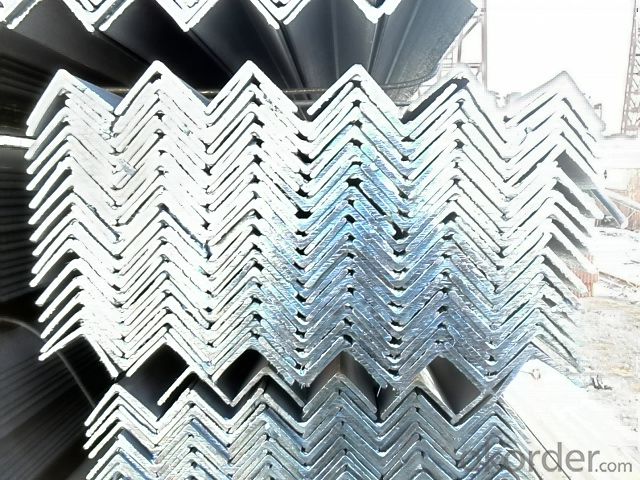
- Q: How do you calculate the strength of a steel angle?
- To calculate the strength of a steel angle, you typically need to consider several factors, including the dimensions of the angle, the material properties of the steel, and the applied loads. The strength can be determined using mathematical equations, such as the yield strength or ultimate strength equations, which take into account the cross-sectional area and moment of inertia of the angle. Additionally, other factors like buckling or lateral torsional buckling may also need to be considered depending on the specific design requirements.
- Q: How do steel angles contribute to the sustainability of transportation systems?
- Steel angles contribute to the sustainability of transportation systems in several ways. Firstly, steel angles are widely used in the construction of infrastructure such as bridges, highways, and railway tracks. These structures have a longer lifespan and require fewer repairs and replacements compared to other materials, resulting in reduced maintenance costs and resource consumption. Moreover, steel angles are highly durable and resistant to harsh weather conditions, ensuring the longevity and safety of transportation systems. This durability minimizes the need for frequent repairs or replacement, reducing the overall environmental impact and carbon emissions associated with transportation infrastructure. Additionally, steel angles have a high strength-to-weight ratio, allowing for the design of lighter and more fuel-efficient vehicles. By using steel angles in the manufacturing of automobiles, trains, and ships, the weight of these vehicles can be reduced, leading to improved fuel efficiency and reduced greenhouse gas emissions during operation. Furthermore, steel angles can be easily recycled at the end of their life cycle. Steel is one of the most recycled materials globally, with a recycling rate of over 85%. Recycling steel angles not only reduces the demand for virgin steel production but also saves energy and reduces greenhouse gas emissions associated with the extraction and manufacturing processes. Overall, the use of steel angles in transportation systems contributes to their sustainability by promoting durability, reducing maintenance needs, improving fuel efficiency, and enabling efficient recycling. These factors collectively help to minimize the environmental impact and enhance the long-term viability of transportation infrastructure.
- Q: What is the typical yield strength of steel angles?
- The typical yield strength of steel angles can vary depending on the specific grade of steel used, but it is typically around 36,000 to 50,000 pounds per square inch (psi).
- Q: Galvanized steel angles under what conditions?
- Galvanized angle itself coated zinc and iron rust, common need to be coated with a layer of anti rust paint in the construction process, so the galvanized angle in the construction without paint. Suitable for field and outdoor support and Engineering
- Q: What are the different types of steel angles used in shipbuilding?
- There are several types of steel angles commonly used in shipbuilding, including equal angles, unequal angles, bulb flats, and hollow sections. These angles are used to provide structural support, reinforcement, and stability to various components of a ship's hull and superstructure.
- Q: Can steel angles be used in the construction of museums?
- Yes, steel angles can be used in the construction of museums. Steel angles are commonly used as structural components in construction projects, including museums. They provide strength, stability, and versatility, making them suitable for various architectural and design requirements in museum construction.
- Q: What are the properties of steel angles?
- Steel angles have several properties that make them highly versatile and widely used in various industries. Firstly, they have excellent strength-to-weight ratio, providing structural stability and support. Secondly, steel angles offer great resistance to corrosion and impact, ensuring durability in different environments. Additionally, they have high malleability and ductility, allowing for easy fabrication and shaping to meet specific design requirements. Lastly, steel angles possess good thermal conductivity and are fire-resistant, making them suitable for applications where heat transfer and fire protection are crucial.
- Q: How are steel angles protected against abrasion?
- Steel angles find common applications in construction and industrial settings, where they are exposed to various forms of abrasion. To safeguard steel angles against abrasion, multiple techniques are employed. One prevalent approach involves the use of protective coatings, such as paints, epoxy coatings, or specialized coatings designed for abrasion resistance. These coatings act as a barrier between the steel surface and abrasive elements, preventing direct contact and minimizing wear caused by friction. Another method entails the application of rubber or plastic linings to the susceptible surfaces of steel angles. These linings absorb the impact of abrasive forces, cushioning the steel and reducing wear. Additionally, they provide an extra layer of protection against corrosion and chemical attacks. In certain cases, steel angles may undergo hardening or heat treatment. This process involves subjecting the steel to high temperatures followed by rapid cooling, altering the steel's microstructure to enhance hardness and resistance to abrasion. Heat-treated steel angles are commonly used in industries with high-wear environments, such as mining and material handling. Furthermore, engineers may choose to design steel angles with specific profiles or shapes that offer improved resistance to abrasion. These profiles may include rounded edges, chamfers, or other features that minimize direct contact with abrasive materials. Overall, protecting steel angles from abrasion involves a combination of protective coatings, linings, heat treatment, and thoughtful design. Implementing these measures significantly prolongs the lifespan and performance of steel angles, reducing maintenance costs and ensuring durability in abrasive environments.
- Q: How are steel angles installed on concrete structures?
- Steel angles are commonly used in concrete structures to provide additional strength and support. The process of installing steel angles on concrete structures involves a few steps. First, the concrete surface needs to be prepared. This includes cleaning the surface thoroughly and removing any debris or loose material. The concrete should be in a sound condition, free from cracks or other structural issues. Next, the steel angles need to be positioned and marked on the concrete surface. This is typically done by using a measuring tape and a chalk line. The angles are usually placed at specific intervals and locations, based on the structural requirements. After marking the positions, the concrete surface needs to be drilled. This is done using a drill and a masonry bit that is appropriate for the size of the anchor bolts or fasteners that will be used. The holes should be drilled to the required depth, ensuring a secure and stable installation. Once the holes are drilled, anchor bolts or fasteners are inserted into the holes. These bolts or fasteners are specifically designed for securing steel angles to concrete surfaces. They are typically made of steel and have a threaded end that allows them to be tightened securely into the concrete. After inserting the anchor bolts or fasteners, the steel angles are positioned and aligned with the marked locations on the concrete surface. The angles are then secured to the concrete by tightening the nuts on the anchor bolts or fasteners. Finally, the installation is checked for accuracy and stability. The angles should be firmly attached to the concrete surface and should not move or shift when pressure is applied. Any adjustments or additional tightening may be necessary to ensure a secure and reliable installation. Overall, the process of installing steel angles on concrete structures involves careful preparation, drilling, anchoring, and securing. This ensures that the angles provide the necessary strength and support required for the specific application.
- Q: What are the different shapes available for steel angles?
- The different shapes available for steel angles include equal angles, unequal angles, and L-shaped angles.
Send your message to us
Hot Rolled Steel Angle Bars in Grade Q235
- Loading Port:
- Tianjin
- Payment Terms:
- TT OR LC
- Min Order Qty:
- 25 m.t
- Supply Capability:
- 10000 m.t/month
OKorder Service Pledge
OKorder Financial Service
Similar products
Hot products
Hot Searches
Related keywords
